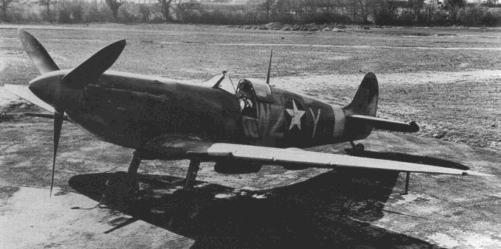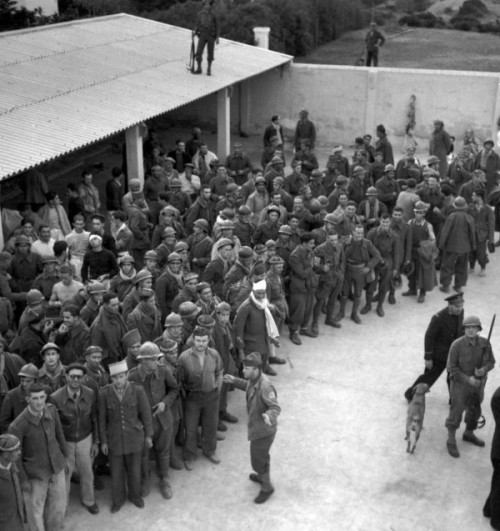"Seeing the Elephant" is an American phrase often used to describe the split between those who have seen combat and those who are still unbloodied. In 1942 the US army first saw the elephant against the Axis forces of Europe. On 8th November, 1942. US forces launched operation Torch. The First in a long line of learning experiences that eventually led to the success of Operation Overlord. However at the time the high command of the US forces were apprehensive about their chances of success. Luckily for the US forces they were only fighting the Vichy French.
The Vichy forces had no new equipment since the fall of France, and were at best confused as to where their loyalties lay. On one hand they wanted to help the allies beat Germany, on the other fear of reprisals should the allied invasion fail was in their mind. With this in mind the Vichy forces did put up a fight.
Task force Centre was to land on a beach near Arzew east of Oran. The its main combat arm was elements of the 1st Armoured Division, along with elements from two tank destroyer battalions and infantry units. At this time nothing as complicated as a Landing Ship Tank existed. So the method of getting the tanks ashore was to load the vehicles onto converted tankers and beach them. Once beached, a pontoon bridge could be created to drive the armoured vehicles off the ship.
Luckily the landing was all but unopposed. So the M3 Stuarts, M3 Lee's and M3 GMC's were unloaded without incident. The vehicles of the 1st armoured were split into two groups. Task Force Green and Task Force Red. Both task forces were immediately dispatched to airfields that had been seized earlier by paratroops. TF Red headed to Tafaraoui, which is about 12 miles South east of Oran. The column moved out at about 0800, with M3 GMC Tank destroyers in the lead.

Not meeting any opposition on their route it took about three dusty, hot hours to reach the Airfield. As they approached the US tanks came under fire. The paratroopers were no where in sight. The original plan had called for the 39 C-47's to land at the airfields, and disgorge their cargo's. However, some planes got lost and on approach enemy Anti-aircraft guns had opened up causing the transports to scatter. Of the 39 planes, two landed in neutral Spanish Morocco, and the occupants interned. Two land at the wrong French airfield and were quickly captured. One plane landed at Gibraltar. A group of planes tried to land at the wrong airfield (the one Task Force Green was heading to) but several planes get shot down on the approach by enemy gunfire. The remainder landed at a dried up lake bed of Sebkra d'Oran, many being damaged in the heavy landing.
With the airbase still in enemy hands TF Red launched an immediate attack. After an hours fighting they capture the airfield and 300 Prisoners. Upon hearing the news the paratroopers re-board their Aircraft to fly to the airfield. However the US forces success is short lived. Vichy aircraft appear overhead and they begin to strafe and bomb the defenceless US troops, shooting several of the C-47's down. One M3 GMC receives a direct hit from a 500Lb bomb, and is utterly smashed, although the five man crew is only wounded.

At that point the troops are saved by the Spitfires of the USAAF 31st fighter group, Who had left Gibraltar upon hearing of the airfields capture. The 31st's planes were due to operate from the airfield. Despite being low on fuel the Spitfires dove on the Vichy DW520 fighters and an dogfight erupted. During which the French are driven off, with the US forces claiming three kills, and the French one kill. As always air to air kills are hard to verify. From losses it appears the French may have only lost one and the US none. With no operational transports the paratroopers are forced to walk to the airfield.

Once the paratroopers secured the airfield dusk was falling. So TF Red prepares to spend the night at the airfield before moving out to help TF Green. As dusk falls Vichy artillery begins to fire on the position. Salvo's are scattered, and the tank destroyers return fire. After a while the artillery duel ends inconclusively. What the US troops didn't realize was the artillery fire was the French guns registering for the next mornings fighting.
A troop of M3 GMC's, under the command of Lt Whitsit, and a force of infantry are sent to screen the rear of the airfield position, this detachment reaches a wadi about 800 Meters from the town of St. Lucien and dig in.
On the 9th TF Red moves out about 0750, all the while under French artillery bombardment. Then comes alarming news, the aircraft operating out of Tafaraoui have spotted enemy tanks in St. Lucien! Three platoons of M3 Stuarts are immediately dispatched to help the US troops facing the town, while the rest of TF Red falls back to prepare better positions around the airfield.
The 30 odd Renault 35's of 1e Régiment de Chasseurs d'Afrique, surge out of St. Lucien. The four US tank destroyers open fire. It is curious to note that the M3 GMC is armed with a French made Mle 1897 75mm gun, a weapon with an unbelievably ferocious rate of fire. The four half-tracks pour fire into the oncoming mass of enemy armour. Their shells smashing the pre-war french tanks, whose armour is totally in effective. Then the Stuarts arrive, driving with two platoons forward, and the third in reserve 500m back. Each platoon is in a wedge. Under the cover of the Tank destroyers guns they drive towards the French tanks. In the short fire-fight that follows one Stuart is destroyed, however the Vichy forces are driven from the field, leaving 14 destroyed tanks burning in the desert sun. Then the Spitfires of the 31st attack, routing the enemy regiment.
/France/Files/1-LightTanks/Renault-R35/R35_01.FVH.jpg)
The following morning Lt Whitsit's platoon rejoined TF Red for the push to capture the town of La Senia. As they approach one of his tank destroyers is hit by an enemy shell and the crew killed. Lt Whitsit's platoon is pulled back to join up with the Rest of TF Red and make an end run around the town to capture Oran with TF Green.
However some forces are left to continue the attack. A mixed bag of M3 Lee's and M3 GMC's attempt to push through the town. As resistance stiffens the platoon commander calls back his M3 GMC's to follow the rest of the company around the town. One M3 GMC commanded by Lieutenant Edson had a faulty radio, and doesn't get the message. Lt Edson follows an M3 Lee into town, where they find a roadblock. The Lee Attempts to bull through but becomes stuck and then is hit by a Vichy anti-tank gun. Lt Edson begins to give covering fire until the Crew of the Lee evacuate safely.

Lt Edson realizes his half-track is now the lead vehicle in the column, so leads a charge forward. As he negotiates the roadblock, made even more complicated by the destroyed Lee his vehicle comes under fire. Bumping through the roadblock damages his front brakes which lock partially on. However the tracks still powered by the engine shoves his tank destroyer forward. The smoke pouring off the brakes and front wheels makes it look like his vehicle is on fire and the French gunners ignore him as he surges forward down the clear road.
As he passes beyond the town, his M3 GMC has to swerve a column of French supply trucks parked by the side of the road. A little further on one of Lt Edson's crew looks behind them and realises they are utterly alone, and no other vehicle is following them. Lt Edson brings his half-track about and returns to the fight. As he approaches the truck convoy his battered half-track finally gives up, and breaks down. With nothing further he can do Lt Edson opens fire on the Vichy trucks, which quickly surrender. The US troops order the 50 POW's to be loaded onto a truck, then orders four of the trucks hitched to his immobilized half-track. With that arranged Lt Edson is towed back into the fight.
Only there is not any fighting. The US attack had been thrown back. The French suddenly and unexpectedly find themselves with enemies on both sides, or so it appears. Without letting on, Lt Edson immediately starts to negotiate the surrender terms of the town. At first the French commanding officer refuses to surrender to a mere Lieutenant. Until Lt Edson assures him he is in radio contact with a General. Once the Vichy officer had that assurance he orders his men to stack arms and his officers to hand over their pistols. The entire battalion of 300 combatants surrender.
Shortly afterwards all the Vichy forces surrendered, bringing operation torch to a successful close. The US troops had seen the Elephant, and next on their list was the Afrika Korps. Which would result in the ill fated battle of Kasserine Pass.





/France/Files/1-LightTanks/Renault-R35/R35_01.FVH.jpg)

